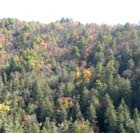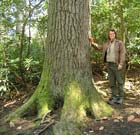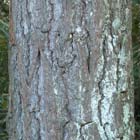Tsuga caroliniana
Engelmann 1881
Common names
Carolina hemlock (Taylor 1993).
Taxonomic notes
Syn.: Abies caroliniana (Engelm.) Chapm. 1883; Pinus caroliniana (Engelm.) Voss 1907 (Farjon 1998).
Description
Trees typically 15-70 cm dbh and 10-20 m tall at maturity. Crown conic, flattening in old trees; first-order branches long, slender, spreading horizontally. Bark smooth, red-brown with yellow resin blisters, with age becoming rough, scaly and fissured, with purple-grey outer bark and red-brown inner bark. Twigs light brown, smooth or finely grooved, thinly covered with short, dark hairs. Vegetative buds oblong, 3-4 mm. Leaves 10-20 mm, mostly spreading in all directions from twigs, flat but slightly revolute; abaxial surface glaucous, with 2 broad, conspicuous stomatal bands, adaxial surface shiny green; margins entire. Seed cones ovoid to oblong, 2.5-4 × 1.5-2.5 cm; scales oblong, 12-18 × 8-12 mm, bases clawed, apex rounded. 2n=24 (Farjon 1990, Taylor 1993). Pollination occurs from March to the end of April. The
cones ripen from late August to late September of the next year; the seed is dispersed from September through the winter (USDA 2005).
Distribution and Ecology
USA: Ohio, Virginia, Tennessee, North Carolina, South Carolina and Georgia at (600-) 750-1200 (-1500) m elevation. Habitat, xeric rocky mountain slopes, or riparian in ravines and canyons, on sites with shallow, nutrient-poor soils. Climate humid, cool, precipitation >1000 mm/yr without a dry season. Commonly occurs in mixed hardwood-conifer stands, or sometimes in pure stands. Common associates include Tsuga canadensis and Pinus strobus), Quercus montana, Quercus alba, Quercus coccinea, Nyssa sylvatica, and various ericaceous shrubs such as Kalmia latifolia, Rhododendron catawbiense, and Rhododendron minus (Farjon 1990, Taylor 1993, VDCR 2005, and pers. obs. Oct-2004). It is an extremely shade-tolerant species so old stands tend to become pure, with mainly Tsuga caroliniana regeneration (USDA 2005). Stand structure varies from closed-canopy to very open, approaching a woodland structure. These communities often occur in patch-mosaics with fire-influenced oak/heath and pine-oak/heath vegetation. This fire-intolerant species is evidently limited mostly to rocky areas and bluffs because they constitute relatively fireproof sites (VDCR 2005).
Currently, the introduced insect pest, hemlock woolly adelgid (Adelges tsugae) poses a major threat to the viability of Carolina hemlock stands (VDCR 2005). Although not a common tree, it is sufficiently abundant that its conservation is not a pressing concern; however, it is listed as "threatened" by the state of Tennessee (USDA, NCRS 2005). T. caroliniana is somewhat less vulnerable to the adelgid than T. canadensis, but chemical and biological treatments are still often necessary to ensure the trees' survival. See T. canadensis for further discussion of the adelgid problem.
Hardy to Zone 6 (cold hardiness limit between -23.2°C and -17.8°C) (Bannister and Neuner 2001). See also Thompson et al. (1999).
Remarkable Specimens
The largest documented was 101 cm dbh and 28.4 m tall with a 12.2 m crown spread, but had recently been killed by hemlock wooly adelgid when it was first measured (Blozan 2013). The official champion was 103 cm dbh, 22.5 m tall, crown spread 11.6 m, in Buncombe, NC, when measured in 2012 (American Forests 2012); as of 2023, there is no stated champion, but all of the largest known specimens are inventoried from the Asheville municipal watershed (not open to public access), and have been treated for adelgid resistance. The watershed includes trees up to 120 cm dbh (Will Blozan pers. comm. 2024.03.08).
The oldest tree on record was specimen 101231, collected in the Kelsey Tract, North Carolina by Ed Cook in 1983. The oldest ring on this sample was crossdated to 1677, making it at least 307 years old (NCDC 2006). The same site had four other trees with over 280 years of record. However, the species has not received much investigation (NCDC records only one other site, and it has a tree with 281 years of record) and much older trees might exist.
Ethnobotany
An attractive ornamental; a number of cultivars have been developed. The wood is of little commercial importance because of the combination of mediocre quality and the relative rarity of the species in nature (Taylor 1993).
The species is useful in dendrochronology, and has been used in several studies, mostly of a descriptive nature or ecological overviews. Probably due to its limited distribution, it has seen far less use than Tsuga canadensis.
Observations
The best site to see it is at Linville Gorge, North Carolina, near the falls. These trees have been treated for adelgid resistance and are also exceptionally large, and exceptionally easy to access. The site also has Tsuga canadensis, Pinus strobus and Pinus virginiana growing in an old and little-disturbed forest amidst rocky canyon scenery.
Remarks
The epithet refers to the species' distribution in the Carolinas, the limits of its known occurrence when T. caroliniana was described in 1881.
Various birds and mammals feed on its seeds, while beaver, and occasionally porcupine and rabbit, eat the bark, and white-tailed deer may browse the foliage in winter. Stands of this species and Tsuga canadensis also provide essential winter shelter and bedding sites for white-tailed deer (USDA 2005).
Seed production begins at about age 20, but good crops do not occur until the trees are 25-30 years old. The wind-dispersed seeds weigh about 2.5 mg. Like other hemlocks, it does not
sprout and only rarely layers. Vegetative propagation by cuttings and grafting are possible (USDA 2005).
Citations
American Forests 2012. The National Register of Big Trees. http://www.americanforests.org/resources/bigtrees/, accessed 2012.02.28, now defunct.
Blozan, Will. 2013.04.22. Potential National Champion Carolina hemlock D.O.A. http://www.ents-bbs.org/viewtopic.php?f=106&t=5311#p23171, accessed 2013.11.22.
Engelmann, George. 1881. Some additions to the North American flora. Botanical Gazette 6:223-224. Available: Biodiversity Heritage Library, accessed 2021.12.18.
Farjon, Aljos. 1990. Pinaceae: drawings and descriptions of the genera Abies, Cedrus, Pseudolarix, Keteleeria, Nothotsuga, Tsuga, Cathaya, Pseudotsuga, Larix and Picea. Königstein: Koeltz Scientific Books.
USDA. 2005. Fire effects information system (FEIS) database. http://www.fs.fed.us/database/feis/plants/tree/tsucar/all.html, accessed 2005.11.06.
USDA, NRCS. 2005. The PLANTS Database, Version 3.5 (http://plants.usda.gov). Data compiled from various sources by Mark W. Skinner. National Plant Data Center, Baton Rouge, LA 70874-4490 USA.
[VDCR] Virginia Department of Conservation and Recreation. 2005. Natural Communities of Virginia - Terrestrial System - Low-elevation Dry & Dry-Mesic Forests & Woodlands: Carolina Hemlock Forests. http://www.dcr.virginia.gov/dnh/ncTIIIh.htm, accessed 2005.11.06, now defunct.
See also
Elwes and Henry 1906-1913 at the Biodiversity Heritage Library. This series of volumes, privately printed, provides some of the most engaging descriptions of conifers ever published. Although they only treat species cultivated in the U.K. and Ireland, and the taxonomy is a bit dated, still these accounts are thorough, treating such topics as species description, range, varieties, exceptionally old or tall specimens, remarkable trees, and cultivation. Despite being over a century old, they are generally accurate, and are illustrated with some remarkable photographs and lithographs.
Humphrey, L. David. 1989. Life history traits of Tsuga caroliniana Engelm. (Carolina hemlock) and its role in community dynamics. Castanea 54(3): 172-190.
James, R.L. 1959. Carolina hemlock - wild and cultivated. Castanea 24: 112-134.
NatureServe. 2005. NatureServe Explorer: An online encyclopedia of life [web application]. Version 4.2. NatureServe, Arlington, Virginia. Available http://www.natureserve.org/explorer, accessed 2005.11.06.
Rentch, J. S., H. S. Adams, R. B. Coxe, and S. L. Stephenson. 2000. An ecological study of a Carolina hemlock (Tsuga caroliniana) community in southwestern Virginia. Castanea 65(1):1-8.
Sargent (1898) provides an exceptionally detailed description of this species, with an excellent illustration.
Photos of herbarium specimens at http://www.ibiblio.org/botnet/flora/tscarherbspec.html, accessed 2004.02.17.






